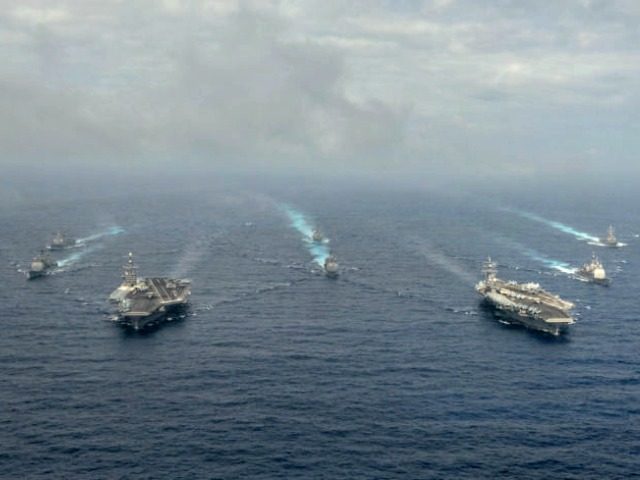Defense Secretary Jim Mattis is currently considering a U.S. Navy plan to sail warships more often by Chinese-claimed islands in the South China Sea, a defense official said Monday.
The plan comes as China has increasingly added military equipment to its arsenal on the Spratly and Paracel Islands in the South China Sea, which Beijing claims as its own despite competing claims by five other East Asian nations.
The plan would see U.S. warships conducting more “Freedom of Navigation Operations,” or FONOPs, within 12 nautical miles of the islands.
The U.S. Navy routinely conducts FONOPs in waters considered to be part of the international domain which would otherwise be claimed by some countries to be within their territorial waters, or a 12-nautical mile distance from their shores.
The plan has already been approved by U.S. Pacific Command, led by Adm. Harry Harris. If approved by Mattis, it will next go to the National Security Council, and then to the president, the official told Breitbart News.
The San Diego-based USS Carl Vinson strike group is in the Pacific Ocean on its way to the East Asian region. It left U.S. Naval Base Guam on Monday after a several-day visit.
Mattis had signaled a potential change in the Navy’s plans during a visit to Japan — China’s regional rival — in early February. “China has shredded the trust of nations in the region,” he said in a joint press conference with his Japanese counterpart on Feb. 4.
“Freedom of navigation is absolute, and whether it be commercial shipping or our U.S. Navy, we will practice in international waters and transit international waters as appropriate,” he said.
The plan would be a departure from the Obama administration, which had restricted such operations to avoid a confrontation with China. During that time, China ramped up its construction and militarization of archipelagoes of small islands and reefs in between Vietnam and the Philippines.
The official said the military had been working for awhile on the plan, first reported by the Navy Times on Monday, and it was not in response to any particular event.
Tensions between China and the Trump administration have been running high since President Trump’s election in November.
Trump on the campaign trail had questioned the “One China” policy, which states that Taiwan is part of China and is the basis of U.S.-Sino relations since 1979.
In early December, Trump accepted a phone call from Taiwanese President Tsai Ing-wen, angering China and breaking decades of U.S. diplomatic protocol.
And last Wednesday, just ahead of a weekend visit to the U.S. by Japanese Prime Minister Shinzo Abe, a Chinese KJ-200 early warning aircraft flew within 1,000 feet of the nose of a U.S. Navy P-3 surveillance plane over the South China Sea.
The Pentagon played down the event, saying there was no evidence the move was intentional.
Since then, Trump spoke with Chinese President Xi Jinping on Friday, reaffirming that he would uphold that policy, which seemed to smooth over some of the tensions.
Bryan McGrath, a retired destroyer captain and consultant with the Ferrybridge Group, said returning to regular FONOPs around the islands is the right move.
“There’s a new sheriff in town, and I think quite rightly the new administration wants to return to a Freedom of Navigation regime that is regular, systematic, and without prejudice,” he told Breitbart News.
“We’re not doing this because ‘we don’t like you, China. We’re doing this because this is what we do,'” he said.
McGrath said the move does risk angering China but that not doing anything would validate Beijing’s unlawful claims.
“It is by regular, routine, systematic disputation of the claim that we actually keep it from becoming recognized law,” he said.

COMMENTS
Please let us know if you're having issues with commenting.